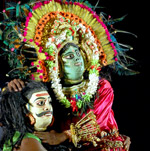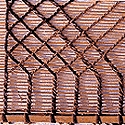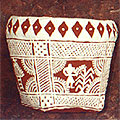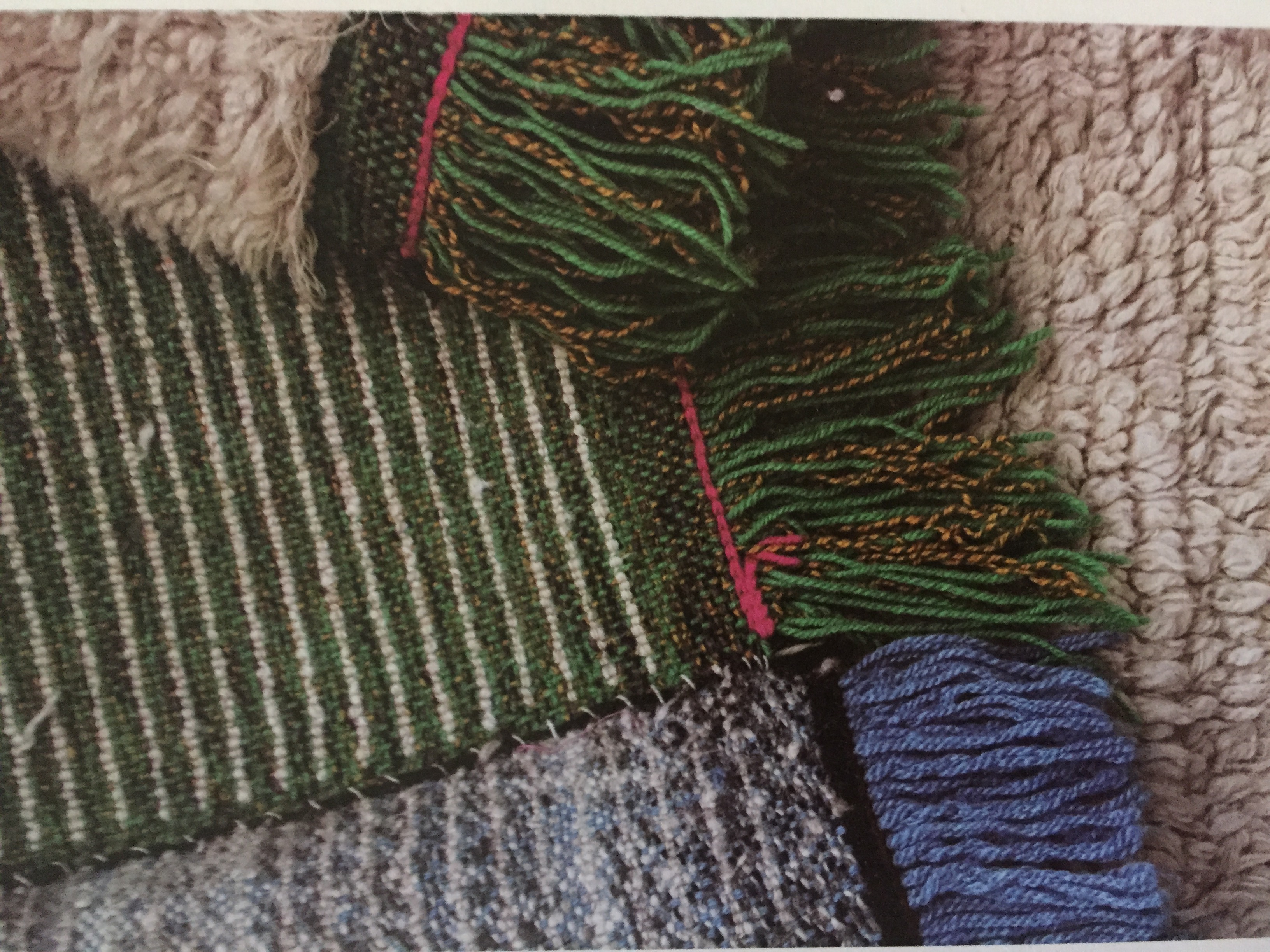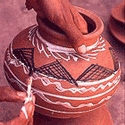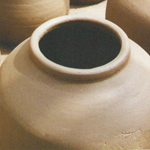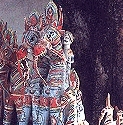The Chettinad Kottans were originally palm-leaf baskets woven in the Chettinad region. This hand-woven basket is woven from strips of palm leaf in the traditional, very distinctive weave pattern. Chettinad basketry has been noted for its unique style and colours. The raw material used is the locally available palm leaf. The process of making the basket involves harvesting of palm leafs, storage, dyeing and weaving. The traditional kottans were used mainly for packaging and as containers for gifts and other articles.
Chhau dance is a folk performance of Puralia, West Bengal. Although it is practiced in other regions of India, they have their distinct and unique features. Chhau Dance in Purulia and Seraikella is performed with a mask. The performance is accompanied with colorful costumes which match with the mask and complete a performer’s attire. The costumes are mostly made of silk. The dance is enacted through mythological stories, epics of Ramayana and Mahabharata and is devoid of any dialogue. It has dance, drama and music. It was primarily a war dance and constitutes of vigorous movements. Chhau dance is only performed by males, no women participate in this dance form. Even the role of women is played my men in disguise. Traditionally, the dance was performed in front of Shiva temple or village square. Today, Chhau dance has found its way to the global stage and is representative of the Bengali culture.
In the hot and dusty plains of North India, chiks have traditionally been used to keep out the dust and blinding heat of the hot summer months keeping the interiors of homes and workplaces cool. This simultaneously utilitarian and decorative product was used widely during Mughal times as screens and partitions in the zenana/women's quarters. The use of chiks was also wide spread during British times but they were mainly of the rougher variety to be used in verandahs and outer public areas. This traditional craft has its roots in the districts and towns of Uttar Pradesh and Delhi. In Delhi the chik makers can be found in Kichripur, Govindpuri and Ashram Chowk.
Chiks are made from bamboo splits or rigid stems of sarkanda grass, held in place by a warp of cotton threads that are finely spaced to create a blinds and screens which can easily be rolled up but not folded or gathered.
Using either Bamboo splits, locally known as tilli or the lower parts of the wild sarkanda grass stems that are sourced from riversides and swampy regions near Delhi and from Meerut in Uttar Pradesh; doubled cotton yarn are individually wrapped around the rigid sarkanda or bamboo splits. To add strength and give a finish the chiks are edged on all sides with a nivar/woven tape. Most are additionally lined with cotton fabric to make them opaque and reduce the sunlight that filters through. Outdoor bamboo chiks that are usually heavier and more sturdy are usually lined with waterproof backing.
Traditional chikankari was originally embroidered with white thread on muslin cloth. Gradually, other fabrics were used as the base; these included organdie, mulmul, tanzeeb, cotton and silk as well as voile, chiffon, linen, rubia, khadi handloom, terry cloth, polyester, georgette. Chikan is essentially a white-on-white embroidery, that is to say white embroidery on white fabric. Predominantly floral designs are executed on fine cotton with untwisted threads of white cotton, rayon or silk. This style of embroidery has evolved over the centuries, reaching its peak in the late 19th century in Lucknow. True chikankari has the unique property of being limited to a fixed repertoire of stitches, each of which is only ever used in a certain way. This repertoire consists of 32 stitches (five of which are common to other forms of embroidery), five derivatives and seven stitches that form an embossed shape, usually a leaf or petal. These small individual petals help identify chikankari. The making process has five different stages, such as cutting, stitching, printing, embroidery, washing and finishing.
The chindi dhurries are so named as the weft strips are created by shredding of cotton fabric or leather strips termed as chindi. A striking feature of the dhurrie is its warp is spun cotton yarn while weft is unspun cotton (chindi) that gives dhurrie a striped look. The Chindi dhurries are identifiable by their characteristic stripes in bold solid colours of red, blue, green and purple etc. The chindi dhurries are now mostly produced in Maharashtra and also in Uttar Pradesh. The raw cotton yarn is procured from Delhi and Agra. The dhurrie making process is flexible and the horizontal loom can be adjusted to make large or small dhurries. The adaptability of the dhurrie weaving process has led to many inventions. Now dhurries are also woven in interesting geometric patterns with bright colours. The art of chindi dhurrie is similar to Panja dhurrie weaving as it uses the same tool (panja) to keep the yarns tight while weaving. The warp is stretched between the two horizontal beams, which can be adjusted according to the size of dhurrie required. The chindi is inserted in the warp yarns with fingers according to pattern on graph. Dhurrie can easily be reproduced in many sizes and colours. Dhurrie weaving in Maharashtra has come out as an important economic activity. These dhurries most commonly adorn the living rooms and bed rooms and find very important use in the prayer rooms.
The Ansari women of Timli village weave chindi or rag durries. The durries are colorful cotton rugs with wefts made from strips of waste fabric and rags. The women make them on pit looms in their homes. The villagers taught themselves how to weave and occupied many women.
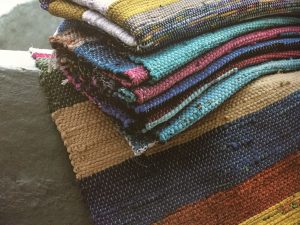
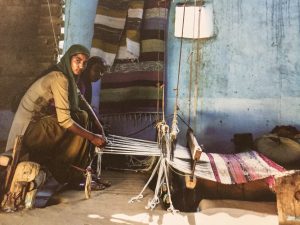
Chitaris is the Marathi word for a painter. A large number of chitaris settled in Nagpur, drawn there by the liberal patronage of the rulers of the Bhonsale dynasty who celebrated Hindu customs and traditions with great pomp and reverence. These chitaris made their homes in the Mahal areas of Nagpur and even today their descendants are found to be living there in a lane known as Chitari Oli. The chitaris' work consists of making objects required during Hindu festivals. The rituals connected with them often require readymade artefacts in wood, clay, and paper. Ganpati has a special significance and the chitaris produce clay images for installation during the Ganpati festival. Over the years changing tastes have lead to a decline in the demand for their work. Today there are only a few families practising in Nagpur. They have now taken to various types of decoration work, including contracts for erecting decorative gates in the city during festivals and marriage decorations. The chitaris work throughout the year except in the summer months when they turn their hand to making marriage platforms and bowlas or conical temple-shaped pavilions for marriages. Different chitaris specialise in different forms and products. Some specialise in the making of three-dimensional idols, chiefly of Ganpati. During the slack seasons they cater to the city shops by creating mannequin figures for draping garments for display. Another group specialises in pata-chitra or paintings on paper and cloth. Among the popular subjects are the jiwti-pata, gajalaxmi-pata, and the nagpanchami-pata. Yet another category of chitaris makes rupdas or the paper masks for Ramlila dramas. During marriages the chitaris are also invited to decorate the facades of the houses with representation of Ganesh, his consorts Riddhi-Siddhi, horse- and elephant-riders, and floral borders.
Chittaras are intricate wall paintings traditionally created by the tribal women of Malnad on their red mud-coated houses, as well as rangoli floor designs. Chittara paintings are part of a larger context of creativity and celebration in the cultural milieu of the region. The chittara art-form however was almost extinct till it was revived recently by Eshwar Naik and his sister Lakshmi, Malnad tribals, who 're-discovered' the artistic and cultural tradition of their forebears (their mother was a skilled chittara artist, with a rich repertoire of songs and music in which the art form was grounded. Eshwar Naik set up a training centre for chittara art, and is focusing on documentation work.
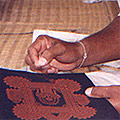
-
White is derived from a mixture of rice (threshed and pounded rice, made into a paste) and white mud
-
Red is made from crushed stone and the abundant red mud in the region
-
Black is also made from rice, which is burnt and then pounded
-
Yellow is made from the seeds of the gurige tree, special to Shimoga and Sagar districts in Karnataka.
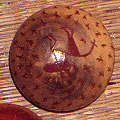

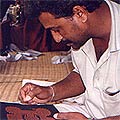
The chunari, a wave-patterned Newari textile that was traditionally a must for wedding ceremonies is now a relatively rare sight. Used during the wedding function in Hindu Brahmin and Kshatriya farmer's homes, the chunari was used as an auspicious wrapping for the dowry gifts taken by the newly-wed bride to her husband's home. Among the Newars, especially of the sakya caste, the chunari fabric was used to wrap up the nuts, pills of keshari, and other items in a bala or brass bowl that was sent along with the bride to her new home. Chunaries were dyed by the chippah caste; however, these textiles are now almost a thing of the past.
The Chutka is a w woven blanket with a shaggy pile, woven and used by the Shauka tribes living in the frontier villages of the north. It is used to sit on and as bedding. It is extremely heavy and thick and weighs between 3 to 4 kilograms. making it a wonderfully effective to withstand the cold and feel cozy and warm.

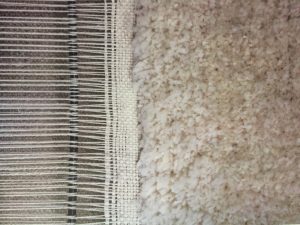
 The Chutka is woven differently in Garhwal and Kumaon.
In Garhwal, the weavers use a verticle loom on which they also weave carpets called dan. Traditionally, the chutka was woven in backstrap looms and the practice continues in some villages in Kumaon.
In Kumaon, the chutka is very often woven on a floor and horizontal loom operated on treadle.
The Chutka is woven differently in Garhwal and Kumaon.
In Garhwal, the weavers use a verticle loom on which they also weave carpets called dan. Traditionally, the chutka was woven in backstrap looms and the practice continues in some villages in Kumaon.
In Kumaon, the chutka is very often woven on a floor and horizontal loom operated on treadle.
For generations, Nepali craftsmen have been making beautiful metal objects - ranging from ornate religious statues and temple decorations, to household vessels, pitchers, cups, and bowls - using the lost wax method. The focus of documentation has traditionally been on the unique bronze statues and there is comparatively little information on the production of simple domestic brass and bronze cast items used in everyday life created using the lost wax method. Household metal utensils like karuwa (water pot with spout), ankhora (water pot, bowls), kasaundi (rice cooking pot), surahi (wine jars), etc. are made by the casting process. They are mainly cast in bronze. The decorated ankhoras and karuwas are unique and the Karuwas of Palpa and Bhojpur districts are famous for their skill in decorating them. Faced with stiff competition from inexpensive, machine-made products, many of the craftsmen over the past few decades have switched to other professions and families that had once passed on these skills to their children have stopped doing so. Thus, the tradition of making these household products by hand is gradually fading away. Though hope lies in the fact that, if it can be afforded, most Nepalese prefer using bronze utensils - believed to be better for a health. Bronze maintains the temperature of the food kept in it, does not leave the taste of the metal in one's mouth, and is durable and long lasting. It also fetches a reasonable price when re-sold.
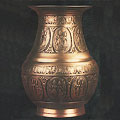


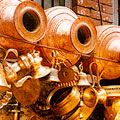
The Nepalese ritual and traditional icons of bronze and copper are famous the world over. The numerous art works in museums and personal collections reflect the superb skill and workmanship of the masters who produced them in the past. This great talent has been nurtured till today by not only the demand within Nepal for sacred and ritual icons but also by buyers from all over the world. These pieces are cast in the lost-wax or cire-perdue process. The technique involves the moulding of beeswax into the desired form, after which the wax is covered with a layer of fine clay and rice-chaff mixture. Meanwhile clay is also deftly tucked inside the image. Once the clay is heated, the wax melts out through a hole in the bottom to leave a hollow mould, hence the name 'lost wax'. When molten bronze has been poured inside and has cooled, the mould is broken and the piece released for further refining. Each piece is therefore unique and individually cast.
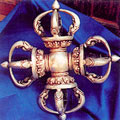
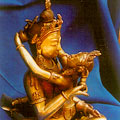
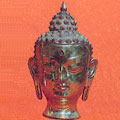
The potters of Himachal Pradesh originally belong to Jammu, Rajasthan, and Punjab and are concentrated mainly in the villages of Kangra, Mandi, Kulu, Chamba, and Shimla. Their place of origin distinguishes their style of working. These potters are locally known as kumhars, kumbhars, or prajapatis, and trace their descent from Lord Vishwakarma. Kangra district is well-known for its distinct red and black pottery. The pots are embellished by painting on them with the traditional white and black colours or by inscribing popular linear and circular patterns with a knife mainly before firing. The products commonly made include pots of different shapes and sizes. These are used for storage and ritual purposes. Diyas or lamps, toys, and figures of Hindu deities are shaped by hand or moulded and then painted in gay colours for the festive season. Kangra in Himachal Pradesh has clay ware in black or dark red colours. The products made are mainly for domestic use: gidya jugs for milk or ghee, patri bowl for curd or butter, and nareles or tobacco-smoking pots.
The earthen pots of Chowra are hand-shaped by the women, with clay taken from the neighbouring island of Teressa. These are low fired using sticks and leaves. The finished pots have a smooth, shining surface and a pattern of thick, dark, chocolate-brown stripes obtained from the juice of the tender coconut husk, which is applied before firing.
Traditionally, the toy industry in Pondicherry used clay; now the material used is papier mache and Plaster of Paris. The craft is concentrated largely in Kosapalayam, a village near Pondicherry town. The toys depict all aspects of Indian life. They are beautifully moulded and attractive in appearance. The craftspersons belong to the kuyavar and kosavar community. The dolls represent different Hindu deities in diverse postures or as symbols of different characters. The style as well as colouring is natural. Figures that are part of ceremonial occasions are shown in orange or rose colour and grey is used to show those engaged in personal labour. If it is a marriage procession, the bride and groom are in orange or pink while the band, the torchbearers, or those carrying gifts are in grey. Passengers riding a vehicle or horse will be in orange or pink. In the case of Plaster of Paris toys, the entire surface is finished with only one colour --- white or cream or pale blue. The jewels and special clothes of deities are splashed with gold colour.
Kumbhara community from Kannipatakka village bring clay from the ponds nearby to shape it into various traditional daily products like water pots, flower pots, animal figurines like elephants and horses. The recent years have seen diversification in the clay products like sculptures in different sizes and products with decorative elements have become more popular.
Assam has a rich tradition of terracotta which has been handed down from generation to generation. There are two traditional potter communities - Hira and Kumhar. The kumhar potters use the wheel and create figurines of gods and goddesses, clay dolls, toys, and pots. Whereas, the Hira community do not use the wheel at all and manufacture household articles using the compression method. Among the Hiras, only the women are engaged in pottery while the men help in procuring raw materials and selling the wares.
The most commonly used pottery products include earthen pots and pitchers, plates, incense-stick holders, and earthen lamps. In Kamrup, terracotta objects including clay tiles are made. Asharkandi, a village in Goalpara district, is famous for its graceful clay dolls. Today, the traditional products are still being made but new shapes and products are also being tried out.
The tradition of clay and terracotta in Bihar dates back to the Mauryan period when hundreds of male and female figurines and animal figures --- horses, elephants, birds, and reptiles --- were made of clay and baked. This tradition continued down to the Mughal period. Each village, district, and region has its own style of pottery and of decoration. The some rituals continue to be practised in their original form. The making of toys and images was --- and is --- closely connected with seasonal festivals and other religious ceremonies. In the past, clay village gods or gram devtas could be seen outside each village, guarding the inhabitants against bad luck, illness, and the wrath of nature. Clay elephants, signifying marriages, could be seen on the roofs of houses. These figures were not merely religious but also served as toys for children and decorations in bed chambers. Sometimes they were hand-modelled, while at other times they were moulded. Today, the potter's art in Bihar is confined to medium and coarse red wares and the making of dolls and toys on festivals and special occasions.
